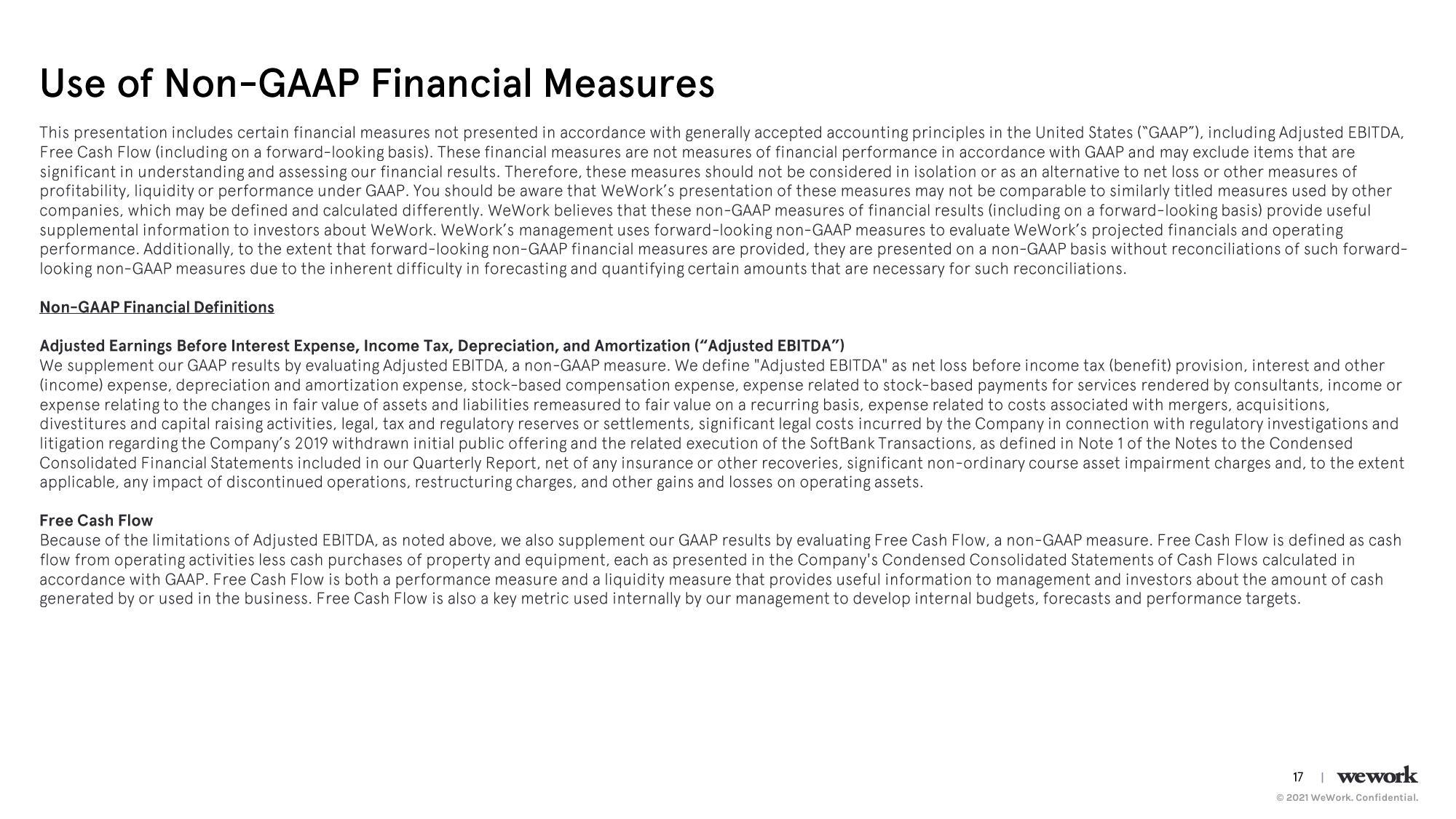WeWork Results Presentation Deck
Use of Non-GAAP Financial Measures
This presentation includes certain financial measures not presented in accordance with generally accepted accounting principles in the United States ("GAAP"), including Adjusted EBITDA,
Free Cash Flow (including on a forward-looking basis). These financial measures are not measures of financial performance in accordance with GAAP and may exclude items that are
significant in understanding and assessing our financial results. Therefore, these measures should not be considered in isolation or as an alternative to net loss or other measures of
profitability, liquidity or performance under GAAP. You should be aware that WeWork's presentation of these measures may not be comparable to similarly titled measures used by other
companies, which may be defined and calculated differently. WeWork believes that these non-GAAP measures of financial results (including on a forward-looking basis) provide useful
supplemental information to investors about WeWork. WeWork's management uses forward-looking non-GAAP measures to evaluate WeWork's projected financials and operating
performance. Additionally, to the extent that forward-looking non-GAAP financial measures are provided, they are presented on a non-GAAP basis without reconciliations of such forward-
looking non-GAAP measures due to the inherent difficulty in forecasting and quantifying certain amounts that are necessary for such reconciliations.
Non-GAAP Financial Definitions
Adjusted Earnings Before Interest Expense, Income Tax, Depreciation, and Amortization ("Adjusted EBITDA")
We supplement our GAAP results by evaluating Adjusted EBITDA, a non-GAAP measure. We define "Adjusted EBITDA" as net loss before income tax (benefit) provision, interest and other
(income) expense, depreciation and amortization expense, stock-based compensation expense, expense related to stock-based payments for services rendered by consultants, income or
expense relating to the changes in fair value of assets and liabilities remeasured to fair value on a recurring basis, expense related to costs associated with mergers, acquisitions,
divestitures and capital raising activities, legal, tax and regulatory reserves or settlements, significant legal costs incurred by the Company in connection with regulatory investigations and
litigation regarding the Company's 2019 withdrawn initial public offering and the related execution of the SoftBank Transactions, as defined in Note 1 of the Notes to the Condensed
Consolidated Financial Statements included in our Quarterly Report, net of any insurance or other recoveries, significant non-ordinary course asset impairment charges and, to the extent
applicable, any impact of discontinued operations, restructuring charges, and other gains and losses on operating assets.
Free Cash Flow
Because of the limitations of Adjusted EBITDA, as noted above, we also supplement our GAAP results by evaluating Free Cash Flow, a non-GAAP measure. Free Cash Flow is defined as cash
flow from operating activities less cash purchases of property and equipment, each as presented in the Company's Condensed Consolidated Statements of Cash Flows calculated in
accordance with GAAP. Free Cash Flow is both a performance measure and a liquidity measure that provides useful information to management and investors about the amount of cash
generated by or used in the business. Free Cash Flow is also a key metric used internally by our management to develop internal budgets, forecasts and performance targets.
17 | wework
Ⓒ2021 WeWork. Confidential.View entire presentation